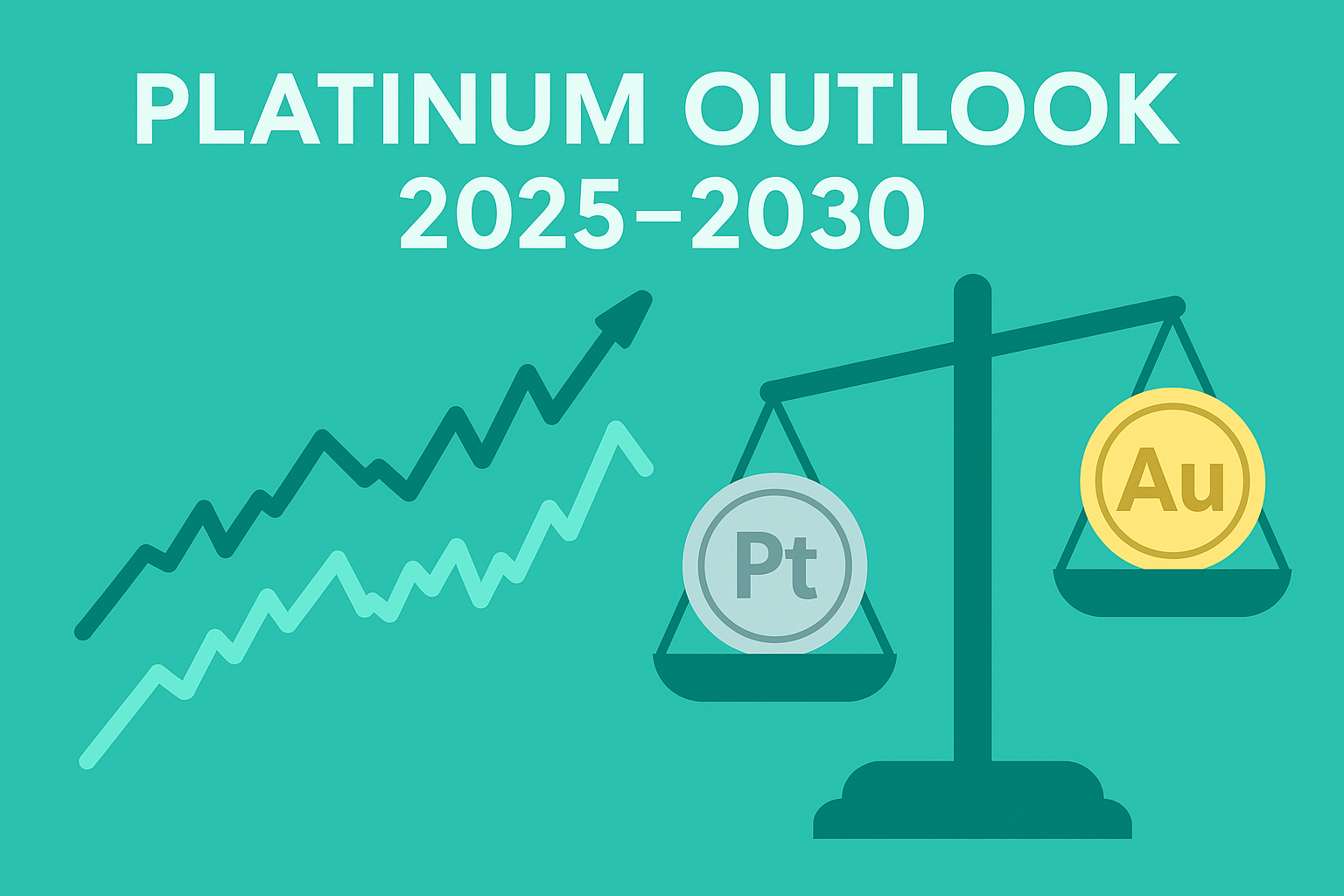— Correlation, Divergence, and Structural Undervaluation versus Gold —
(Prepared by Global Economist Research, Oct 2025)
- 1. Executive Summary
- 2. Platinum’s Dual Identity: Monetary and Industrial
- 3. Historical Valuation: The “Platinum Discount Era”
- 4. Supply and Demand Dynamics
- 5. Macro Correlation with Gold
- 6. Forecast Scenarios (2026–2030)
- 7. Investment Implications
- 8. Risk Assessment
- 9. Strategic View (Economist’s Conclusion)
1. Executive Summary
As gold commands record highs above $3,900/oz, platinum remains significantly undervalued at less than half that price. Yet, the structural backdrop for platinum is strengthening — driven by persistent supply deficits, catalytic converter substitution from palladium, and the long-awaited rise of hydrogen technologies.
Core Thesis:
Over the next five years, platinum will outperform gold on a relative basis as industrial and green-energy demand stabilizes while gold’s momentum plateaus.
The Platinum-to-Gold ratio (Pt/Au), which has remained near historic lows since 2015, is set for gradual normalization — a reversion toward 0.6–0.7 by 2027–2028.
2. Platinum’s Dual Identity: Monetary and Industrial
Unlike gold, whose value rests primarily on its monetary and hedging role, platinum embodies dual utility:
| Function | Drivers | Price Effect |
|---|---|---|
| Precious-Metal Role | Correlates with gold via macro sentiment — real rates, dollar index, and risk appetite. | Moves with “safe-haven” flow, moderate beta to gold. |
| Industrial-Metal Role | Anchored in auto catalysts, hydrogen fuel cells, and chemical processes. | Adds cyclicality and supply sensitivity. |
This hybrid nature makes platinum a bridge asset between gold’s monetary value and palladium’s industrial volatility. It means correlation with gold is positive but unstable — historically 0.45–0.65, falling sharply when industrial demand dominates.
3. Historical Valuation: The “Platinum Discount Era”
- Before 2011, platinum routinely traded at a premium to gold (Pt/Au > 1) due to its rarity and industrial intensity.
- Since 2015, platinum has traded at a persistent discount (Pt/Au ≈ 0.45–0.55) — the longest undervaluation stretch in modern history.
- As of October 2025, the ratio stands near 0.49, reflecting gold’s monetary surge and platinum’s cyclical lag.
Economist’s View:
The structural divergence is overextended. As gold stabilizes and real yields plateau, platinum’s industrial fundamentals will drive a convergence phase — not through gold’s fall, but through platinum’s revaluation.
4. Supply and Demand Dynamics
(1) Persistent Supply Deficit
The World Platinum Investment Council (WPIC) projects annual supply deficits of 0.6–0.9 million ounces through 2029, driven by:
- Power disruptions and underinvestment in South African mines (≈70% of global output).
- Declining recycling yields post-pandemic.
- Limited new project pipelines.
(2) Auto Catalyst Substitution — A Structural Shift
- Since 2022, automakers have accelerated palladium-to-platinum substitution in gasoline catalytic converters.
- WPIC estimates 0.6–0.7 million ounces per year of sustained incremental platinum demand.
- Once adopted, this substitution is sticky — reversing it requires costly redesigns.
(3) Hydrogen Economy and Net-Zero Industrialization
- PEM (Proton Exchange Membrane) electrolysis and fuel-cell systems depend on platinum-group catalysts.
- Global hydrogen expansion plans (EU, U.S., China) could lift demand by 800–900k oz annually by 2030 — equivalent to ~10% of total global platinum consumption.
- However, project execution remains slow; the true demand boom may not materialize before 2027–2028.
(4) Investment and Jewelry Demand
- Investment flows into platinum ETFs remain modest but stable, with growing interest from Asia.
- Jewelry demand in China and India has recovered gradually, providing a soft floor under spot prices.
5. Macro Correlation with Gold
| Factor | Gold | Platinum | Correlation Interpretation |
|---|---|---|---|
| Real Interest Rates (U.S.) | Strong inverse | Moderate inverse | Platinum benefits if gold strengthens under falling real yields, but less so if industry weakens. |
| Dollar Index (DXY) | Negative | Negative | Similar directional response, though platinum’s elasticity is smaller. |
| Global Industrial Output | Weak | Strong positive | Platinum benefits directly from industrial cycles, gold does not. |
| Risk Aversion (VIX) | Positive | Mixed | Gold rises with volatility; platinum depends on whether industrial demand outweighs fear. |
Conclusion:
Gold defines the macroeconomic floor, but platinum defines the cyclical ceiling.
When the global economy slows but avoids deep recession — a likely scenario in 2026–2028 — platinum’s beta to gold flips positive and outperforms.
6. Forecast Scenarios (2026–2030)
| Scenario | Macro Assumptions | Gold (avg.) | Platinum (avg.) | Pt/Au Ratio | Commentary |
|---|---|---|---|---|---|
| Base Case (60%) | Gold stabilizes near $3,600–3,900; moderate global growth | $3,800 | $2,300–2,600 | 0.6–0.7 | Gradual convergence, hydrogen ramps mid-decade. |
| Bull Case (25%) | Sustained deficits + industrial rebound | $4,000 | $2,800–3,200 | 0.7–0.8 | Platinum breaks structural undervaluation; reclaims monetary premium. |
| Bear Case (15%) | Supply recovery + delayed hydrogen rollout | $3,400 | $1,800–2,000 | 0.5–0.55 | Industrial drag caps upside despite safe-haven spillover. |
Long-term equilibrium fair value: ~$2,600–2,800/oz by 2028 under balanced macro and energy transition progress.
7. Investment Implications
(1) Relative Trade – Pt/Au Spread
- Use the platinum/gold ratio as a valuation gauge.
- Historically, Pt/Au < 0.5 has marked entry zones for platinum accumulation.
- Target reversion toward 0.65–0.7 offers potential relative return >25% versus gold.
(2) Industrial Leverage Plays
- Prefer miners with exposure to both PGMs (platinum group metals) and hydrogen infrastructure.
- South Africa’s supply risk adds volatility but also premium potential.
(3) Macro Hedging Function
- While gold serves as monetary insurance, platinum adds industrial beta — together they create a balanced inflation/deflation hedge pair.
(4) Hydrogen as a “Call Option”
- Treat hydrogen-linked platinum demand as a long-dated call option on global decarbonization.
- Policy milestones (EU hydrogen bank, U.S. Inflation Reduction Act 2.0 funding, China’s hydrogen clusters) will drive periodic repricing.
8. Risk Assessment
| Risk | Probability | Impact | Commentary |
|---|---|---|---|
| Supply Recovery in South Africa | Medium | Negative | Eskom’s power stabilization could ease deficits. |
| Palladium Price Recovery | Medium | Negative | Reduces substitution momentum. |
| Hydrogen Project Delays | High | Moderate | Pushes demand bump beyond 2028. |
| Recession Shock (Industrial Demand Collapse) | Low–Medium | Severe (short term) | Price could dip below $1,800, but deficits persist. |
| Policy Upside (Hydrogen Subsidy Acceleration) | Medium | Positive | Could trigger sustained bull cycle post-2027. |
9. Strategic View (Economist’s Conclusion)
“Platinum is transitioning from a forgotten metal to a strategic commodity of the green economy.”
While gold’s story in 2025 is about monetary fear, platinum’s story is about industrial rebirth.
The macro correlation with gold remains meaningful, but the drivers are diverging: gold reflects anxiety, platinum reflects adaptation.
Between 2026 and 2030, platinum’s supply deficit and technological relevance will likely reprice the market closer to historical parity with gold — not as a speculative rush, but as a structural normalization of its true economic value.
📊 Data Sources
- World Platinum Investment Council (WPIC) – 2025 Q2 & Q3 Reports
- CME Group / LBMA – Precious Metals Market Data
- IEA Hydrogen Outlook 2025
- BloombergNEF / Metals Focus
- Reuters Commodities Desk (Oct 2025)


